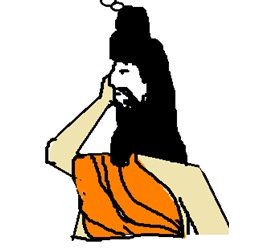Believe it or not! Geometry just happened during Vedic Rituals, for him.
Baudhayan coined many geometrical concepts, one amongst them now known as “Pythagoras Theorem”. Before quoting Baudhayan, let’s find out who was Pythagoras.
According to experts, Pythagoras could have existed during the period from 570 BC to 490 BC. However, there is a mystery surrounding him. Firstly, the mathematical achievements of Pythagoras are not known because nothing is available of his writing at the History of Mathematics Archive, University of St. Andrew, Scotland. Secondly, he is related to the existence of a mysterious society or school founded in Italy. But Yes! All of us know what Pythagoras’ theorem is, which of course forms the basis of many core concepts. So, it’s natural for us to imagine an extraordinary man who did conscious studies on casual happenings like an apple falling on him or he might have been a research scholar who dedicated his life to unleashing the core concepts. Not all of us can be as genius as Pythagoras, a great mathematician!
Hey! Wait. What about Baudhayan? Let’s have a look. The current consensus is to assign Baudhayan texts, the period 800-400 B.C. The Sulva-Sutras is one of the texts that appear to be the earliest treatises of Indian Geometry. And this man, Baudhayan, created addendums to such texts to perform precise Vedic Rituals! In other words, he wanted a precise Geometry of the tools to perform perfect Vedic Rituals. This means, Baudhayan accidentally created detailed Geometry to full fill his ritualistic devotion. Sounds strange! But references to Sulva-Sutra reveal this fact i.e. there are appendices to ritual treatises in Sulva-Sutra to provide directions for the construction of ritual areas and ritual brick structures described in these treatises. Four such appendices are the Baudhayan Sulva Sutra, the Katyayana Sulva Sutra, the Apastamba-Sulva-Sutra, and the Manava-Sulva-Sutra.
We are confined to Baudhayan Sulva Sutra, a small part of the original text known as Sulva-Sutra. Also, the Pythagoras Theorem, now, is just one of Baudhayan’s works where he used a rope as an example in the referred shloka which can be translated as “The areas produced separately by the length and the breadth of a rectangle together equal the areas produced by the diagonal.” There have been various arguments and interpretations of this. It can be argued that side refers to the sides of a rectangle, for others the reference could be to that of a square. But, a diagonal of a rectangle or a square is a hypotenuse in a right-angle triangle formed by halving a rectangle or a square diagonally. And Yes! There is no evidence to suggest that Baudhayan’s formula is restricted to right-angled isosceles triangles because it can be related to other geometrical figures as well.
Baudhayan’s other works include Circling a square i.e. Baudhayan was able to construct a circle almost equal in area to a square and vice versa. These procedures are described in his sutras (1-58 and 1-59). Secondly, Baudhayan was able to coin the concept of a constant similar to “∏”. Several values of this constant occur in Baudhayan’s Sulva-Sutra since when giving different constructions, Baudhyan used different approximations for constructing circular shapes. So these values are very close to the value of “∏” today, without impacting the construction of original Vedic Structure. Lastly, Baudhayan gives the length of the diagonal of a square in terms of its sides, which is equivalent to a formula for the square root of 2. The measure is to be increased by a third and be a fourth decreased by the 34th. That is it’s diagonal approximately. That is 1.414216, which is correct to give places of decimal.
Before knowing about Baudhayan, it would have been impossible to believe that devotion can end up in discoveries and inventions. But that’s how Vedic Culture was woven in tangibles amidst the intangible consciousness of human life. It was a science of synergy which covered the entire universe (Brahm-) in an eggshell (-and) i.e. Brahmand. Now, if someone refutes Rishi Baudhyan being a Mathematician, he is correct! He was an aspiring devotee and the modern-day theorems such as “Pythagoras” are mere byproducts of his devotion towards the Supreme. Rishi Buadhayan’s theorem was not limited to right-angled isosceles triangles, it was rather vast and elaborative. Hence for the people suffering from “Down’s Mania” where they have a habit of looking down at everything that was Vedic or now Indian, Baudhyan theories are not good news.
Article authored by Veena & Prachi.
![]()
- Shivkar Bapuji Talpade, the first flight engineer? - August 2, 2025
- Did Western Scientific Discoveries Draw Inspiration from Indian Sanatan Literature? - July 24, 2025
- “Jaanta Raja” – Roar of the Great Maratha! - February 19, 2023

